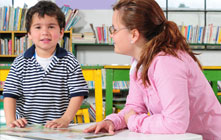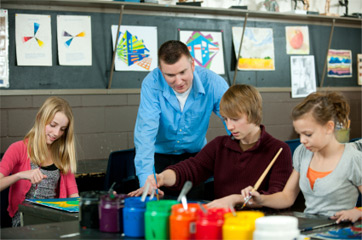Elementary Reading: Breaking Down the Components of a Plot
Third and fourth graders learn about basic reading concepts including the various parts of plot, as well as characters and setting. Parents and students can work together at home to reinforce what a child learns in school. Read on to learn more about identifying characters, determining the setting, and understanding the plot of a book or story.

Third and fourth graders learn about the components of a story in their elementary reading classes. Teachers work hard to teach students about the characters, setting, plot. Some children have a hard time identifying the various concepts when reading a story. By learning about these components yourself, you can work with your third or fourth grader to help improve their grasp of this information.
Identify Main Characters
The main characters of a story are what bring it to life. An author gives them personalities that come out in the way they talk and interact with other characters. One way to help a child understand and relate to characters is to take notes on the person. Have your student look through the first part of a story to find their favorite quote from each character. Ask what can be learned from what the characters say. See if your child can find what the quotes say about the character's personality. You might also instruct your child to draw a picture of the characters, or look through magazines to find someone who looks how they imagine the character to be. These simple exercises can connect your third or fourth grader to the story in a much deeper way than simply reading it.
Setting
Your child will need to understand setting and be able to discuss its role in the story. The setting is the location and time in which the story takes place. With the setting comes important details and information. For example, a story set in the Midwest during the Great Depression will portray a lot of poverty, while a novel about a successful and young businessperson during the dot com craze may employ a very different backdrop. The characters also will most likely be very different. Help your child understand the concept of setting by comparing their own life with life portrayed in the story. Ask him how his own surroundings differ from those in the story. Research together how the time period in the novel is different from current day.
The Four Parts of a Plot
The Conflict
The main conflict gives the story purpose and drives it to completion. It's helpful for young students to read about problems they can relate to. If the challenges faced by the main character of a story are similar to those the reader faces, the reader will be better able to identify them as problems. It might be hard for a child to recognize the central problems of a struggling painter, but the problems faced by a boy living on a farm in Oklahoma might be easier to understand
Rising Action
The rising action usually appears near the beginning or toward the middle of the book. The character and setting have been established and readers start to learn about the main problem facing the characters. The characters struggle with the problem looking for the best solution. The rise of action usually consists of how the character deals with the problem. It allows the reader to bond with the characters and the story and helps them to identify with the situations.
The Climax
The climax is when the main action has occurred, initiating a turn in action and reaching toward the solution of the primary problem. It is critical for a student to recognize this part of the story because it's the culmination of all the action leading up to it. If a student can't identify the climax of a novel it might mean they haven't fully understood all of the action that has occurred. Quiz your child while they're reading to make sure that they are keeping up with the main plot points. Ask your elementary student which part of the novel they think they are reading. If you notice a critical point has occurred but your child did not put much emphasis on the action, encourage them to reread this part of the novel.
The Resolution
The resolution when all of the lose ends are tied up. The main characters have found the resolution to their problem and have learned or are learning how to deal with the resulting situation. At this point your child should feel satisfied with the story and be able to retell the story to a parent, highlighting the main characters, setting, and the four main components of the story's plot.
Other Articles You May Be Interested In
-
Can Reading Bridge Racial, Socioeconomic Gaps?

Study after study shows the achievement gap in education between students of different cultures and economic backgrounds. Recently, two New Jersey schools successfully used literature to show students how 'the other half lives'. Can this experiment be a model for other schools to use books to bridge racial and socioeconomic...
-
Too Much Emphasis on Reading and Math?

According to a large number of surveyed educators who teach grades 3-12, U.S. public schools are spending too much time on reading and math and not enough on other subjects. Yes, math and reading are important. But what about science, foreign languages and social studies?
We Found 7 Tutors You Might Be Interested In
Huntington Learning

- What Huntington Learning offers:
- Online and in-center tutoring
- One on one tutoring
- Every Huntington tutor is certified and trained extensively on the most effective teaching methods
K12

- What K12 offers:
- Online tutoring
- Has a strong and effective partnership with public and private schools
- AdvancED-accredited corporation meeting the highest standards of educational management
Kaplan Kids

- What Kaplan Kids offers:
- Online tutoring
- Customized learning plans
- Real-Time Progress Reports track your child's progress
Kumon

- What Kumon offers:
- In-center tutoring
- Individualized programs for your child
- Helps your child develop the skills and study habits needed to improve their academic performance
Sylvan Learning

- What Sylvan Learning offers:
- Online and in-center tutoring
- Sylvan tutors are certified teachers who provide personalized instruction
- Regular assessment and progress reports
Tutor Doctor

- What Tutor Doctor offers:
- In-Home tutoring
- One on one attention by the tutor
- Develops personlized programs by working with your child's existing homework
TutorVista

- What TutorVista offers:
- Online tutoring
- Student works one-on-one with a professional tutor
- Using the virtual whiteboard workspace to share problems, solutions and explanations